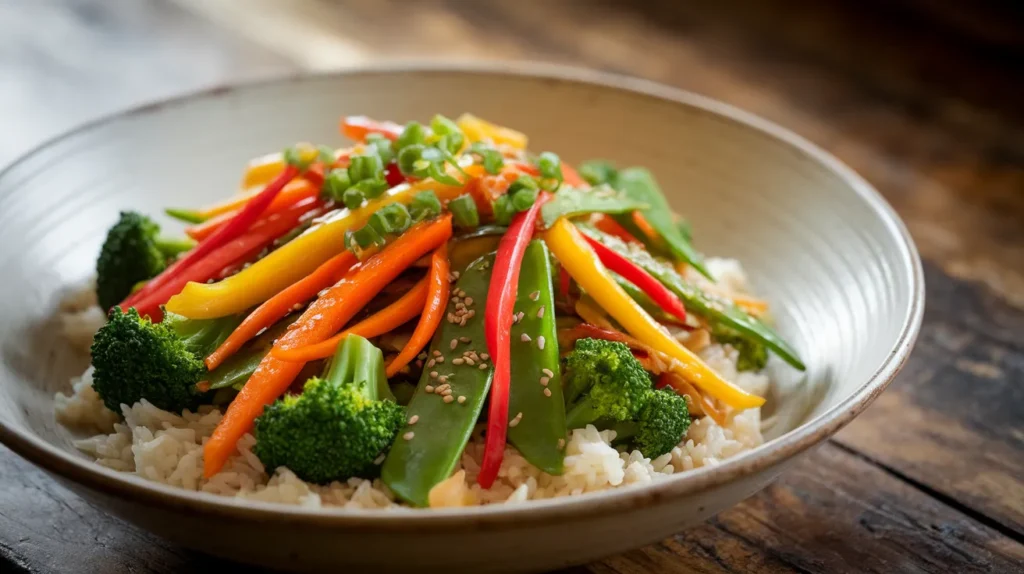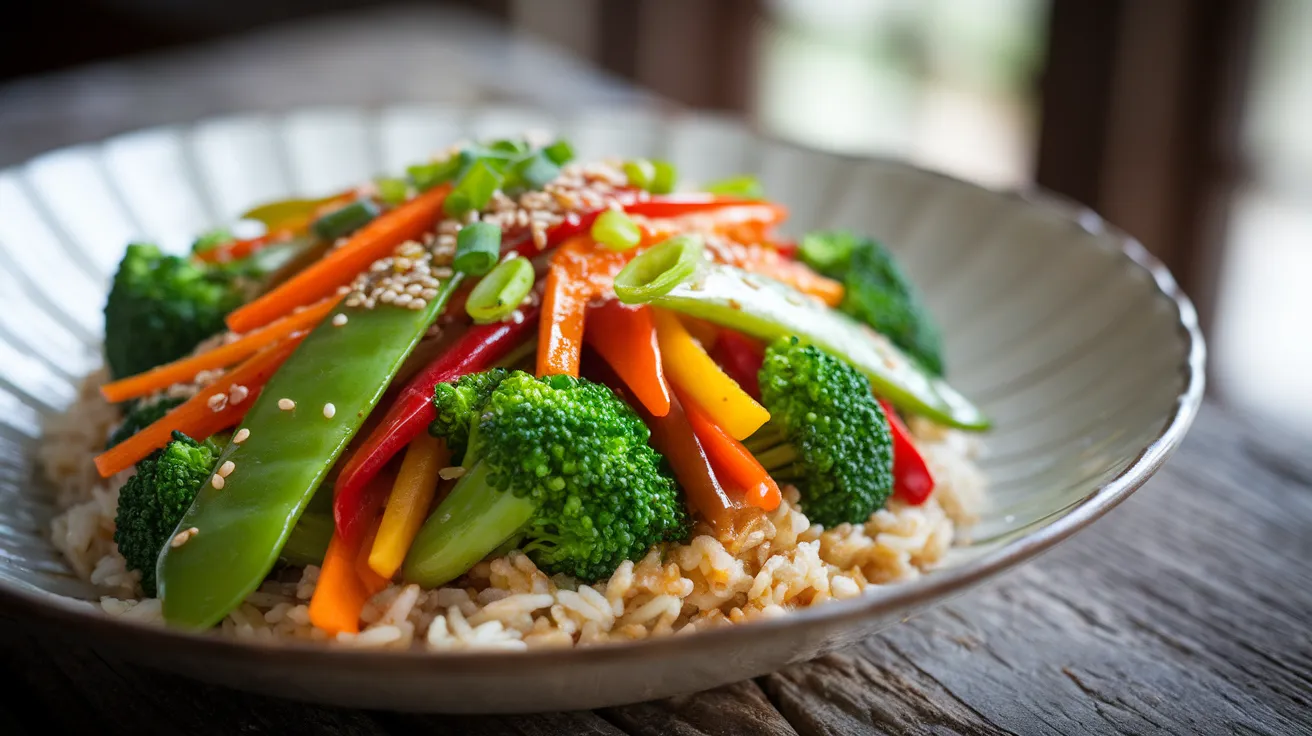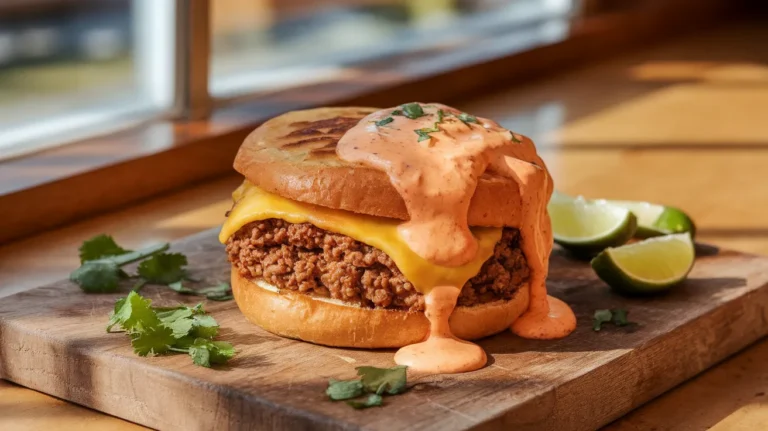This foolproof sauce for veggies and rice transforms ordinary ingredients into an extraordinary meal that tastes like takeout. Perfect for beginners, this sauce for veggies and rice recipe uses simple pantry staples to create a glossy, flavorful coating that makes healthy eating delicious and satisfying.
SERVES: 4 | PREP: 15 MIN | COOK: 25 MIN | TOTAL: 40 MIN
Ingredients
For the Base Sauce
| Ingredient | Amount |
|---|---|
| Soy sauce (low-sodium) | 1/3 cup |
| Rice vinegar | 2 tablespoons |
| Sesame oil | 1 tablespoon |
| Honey | 2 tablespoons |
| Fresh ginger, minced | 1 tablespoon |
| Garlic cloves, minced | 3 large |
| Cornstarch | 1 tablespoon |
| Water | 1/4 cup |
For the Vegetables
| Ingredient | Amount |
|---|---|
| Broccoli florets | 2 cups |
| Bell peppers, sliced | 2 medium |
| Carrots, julienned | 2 large |
| Snow peas | 1 cup |
| Green onions, chopped | 4 stalks |
| Vegetable oil | 2 tablespoons |
For Serving
| Ingredient | Amount |
|---|---|
| Jasmine rice, cooked | 3 cups |
| Sesame seeds | 1 tablespoon |
Detailed Step-by-Step Instructions for Beginners
Phase 1: Preparing Your Sauce for Veggies and Rice (8 minutes)
1. Create the cornstarch slurry first (this prevents lumps later)
- In a small bowl, measure 1 tablespoon cornstarch
- Add 1/4 cup cold water to the cornstarch
- Using a fork or small whisk, mix until the mixture is completely smooth and white (no lumps should be visible)
- Set this aside – you’ll use it later to thicken your sauce
- Why this matters: Cold water prevents the cornstarch from clumping when we add it to hot liquid
2. Prepare your fresh aromatics (ginger and garlic)
- Peel 1 tablespoon of fresh ginger using a spoon edge (this scrapes the skin off easily)
- Mince the ginger into tiny pieces, about 1/8-inch in size
- Peel 3 large garlic cloves and mince them just as finely as the ginger
- Keep ginger and garlic separate on your cutting board for now
- Tip: If your eyes water from the garlic, rinse your knife with cold water every few cuts
3. Mix your sauce base ingredients
- In a medium bowl (about 2-cup capacity), combine these liquids in this order:
- Pour in 1/3 cup soy sauce first (this forms your base)
- Add 2 tablespoons rice vinegar (this adds tang)
- Drizzle in 1 tablespoon sesame oil (this adds nutty flavor)
- Add 2 tablespoons honey (this balances the saltiness)
- Important: Don’t add the ginger and garlic yet – they go in during cooking
4. Test your sauce balance before cooking
- Dip a clean teaspoon into your sauce mixture
- Taste it – you should notice sweet, salty, and tangy flavors equally
- If too salty, add 1 more teaspoon honey
- If too bland, add 1 more teaspoon soy sauce
- Remember: The sauce will taste stronger when reduced during cooking
Phase 2: Preparing Vegetables for Even Cooking (10 minutes)
5. Wash and dry all vegetables thoroughly
- Rinse broccoli, bell peppers, carrots, snow peas, and green onions under cold running water
- Pat everything completely dry with paper towels or clean kitchen towels
- Why this matters: Wet vegetables will cause dangerous oil splattering and won’t brown properly
6. Cut broccoli into uniform pieces
- Cut broccoli into florets about 1-inch in size (roughly bite-sized)
- If stems are thick, slice them into thin coins so they cook at the same rate
- All pieces should look similar in size for even cooking
- Visual cue: Each piece should fit comfortably on a fork
7. Prepare bell peppers for quick cooking
- Remove stems, seeds, and white membranes from 2 bell peppers
- Cut peppers into strips about 1/4-inch wide and 2 inches long
- Try to make all strips the same thickness so they cook evenly
- Tip: Any color bell pepper works – red, yellow, and orange are sweeter than green
8. Create carrot matchsticks
- Peel 2 large carrots with a vegetable peeler
- Cut carrots into 2-inch long pieces first
- Cut each piece lengthwise into thin slices (about 1/8-inch thick)
- Stack slices and cut into thin matchstick strips
- Goal: Carrot pieces should be thin enough to cook quickly but thick enough to maintain crunch
9. Prepare snow peas and green onions
- Remove stems and strings from snow peas by snapping off the stem end and pulling the string down
- Cut green onions into 1/2-inch pieces, separating white and green parts
- Keep white parts with other vegetables, set green parts aside for garnish
- Note: Snow peas cook very quickly, so they’ll be added last
10. Organize vegetables by cooking time
- Bowl 1 (longest cooking time): Carrots and broccoli
- Bowl 2 (medium cooking time): Bell peppers and white parts of green onions
- Bowl 3 (shortest cooking time): Snow peas
- Bowl 4 (garnish only): Green parts of green onions
- This organization prevents overcooking and ensures perfect texture
Phase 3: Cooking Your Sauce for Veggies and Rice (15 minutes)
11. Heat your pan to the correct temperature
- Place a large skillet or wok over medium-high heat (about 7 out of 10 on your stove)
- Let the pan heat for 2-3 minutes until it feels hot when you hold your hand 4 inches above it
- Add 2 tablespoons vegetable oil and swirl to coat the bottom
- Temperature test: The oil should shimmer and move easily but not smoke
12. Start cooking the firmest vegetables first
- Add carrots and broccoli to the hot oil (you should hear immediate sizzling)
- Don’t stir for the first 30 seconds to allow browning
- Then stir constantly for 3-4 minutes using a wooden spoon or heat-safe spatula
- Visual cues: Vegetables should turn bright in color and have slight brown edges
- Texture check: Pieces should be tender when pierced with a fork but still have crunch
13. Add medium-cooking vegetables
- Push carrots and broccoli to one side of the pan
- Add bell peppers and white parts of green onions to the empty side
- Stir everything together and cook for 2-3 more minutes
- What you’re looking for: Bell peppers should soften slightly but maintain their shape and color
14. Add quick-cooking vegetables last
- Add snow peas to the pan with other vegetables
- Stir everything together and cook for just 1 minute
- Important: Snow peas should stay bright green and crisp – they cook very quickly
15. Create space for your sauce
- Using your spoon or spatula, push all vegetables to the edges of the pan
- This creates an empty well in the center where you’ll add your sauce
- Why this technique works: Heating the sauce separately before mixing prevents the vegetables from overcooking
16. Add aromatics and sauce base
- Add your minced ginger and garlic to the empty center well
- Cook for 15-20 seconds until fragrant (you’ll smell them immediately)
- Pour your sauce mixture (soy sauce, vinegar, sesame oil, honey) into the center
- Let it bubble and steam for 30-45 seconds before stirring
- Safety tip: The mixture will bubble vigorously – this is normal
17. Thicken your sauce with cornstarch slurry
- Stir your cornstarch and water mixture one more time (it separates when sitting)
- Slowly pour the slurry into the bubbling sauce while stirring constantly with your other hand
- Critical technique: Pour slowly and stir constantly to prevent lumps
- Continue cooking and stirring for 1-2 minutes until the sauce thickens noticeably
18. Check sauce consistency and combine everything
- The sauce should coat the back of your spoon but still flow easily
- If too thick, add 1 tablespoon hot water and stir
- If too thin, cook 1-2 minutes longer while stirring
- Now mix all vegetables with the thickened sauce until everything is evenly coated
- Final result: Every piece of vegetable should glisten with sauce
19. Final seasoning and garnish
- Remove the pan from heat (this stops the cooking process)
- Taste a piece of vegetable with sauce – adjust seasoning if needed
- Add a pinch of salt if the sauce tastes flat, or 1 teaspoon honey if too salty
- Stir in the green parts of the green onions for fresh color and mild onion flavor
- Presentation tip: Sprinkle sesame seeds over everything for crunch and visual appeal
Chef’s Notes for Perfect Sauce for Veggies and Rice
• Sauce consistency is everything. The perfect sauce for veggies and rice should cling to ingredients without being thick like paste. It continues thickening as it cools, so err on the slightly thin side while cooking.
• Vegetable prep determines success. Cutting vegetables uniformly ensures they all finish cooking at the same time. This technique keeps colors vibrant and prevents mushy textures that ruin the dish.
• High heat creates better flavors. Don’t be afraid of the sizzling sounds – this browning (called the Maillard reaction) develops deeper, more complex flavors than gentle cooking methods.
• Fresh aromatics make the difference. Using fresh ginger and garlic instead of powdered versions creates bright, zesty notes that make this sauce for veggies and rice taste restaurant-quality.
Nutrition Information (Per Serving)
- Calories: 245
- Protein: 8g
- Carbohydrates: 42g
- Fat: 6g
- Fiber: 4g
- Sugar: 12g
- Sodium: 680mg
Creative Sauce for Veggies and Rice Variations
Spicy Asian Style: Add 1-2 teaspoons chili garlic sauce with the ginger and garlic. Start with less – you can always add more heat, but you can’t take it away.
Peanut Butter Version: Whisk 2 tablespoons natural peanut butter into your sauce base. This creates a creamy, protein-rich coating similar to Thai peanut sauce. For more Asian-inspired flavors, explore our sauce for rice bowls collection.
Coconut Curry Twist: Replace half the soy sauce with canned coconut milk and add 1 teaspoon yellow curry powder. This transforms your dish into a mild, creamy curry experience.
Breakfast Bowl Style: Use this same technique for morning vegetables by reducing soy sauce to 2 tablespoons and checking out our sauce for breakfast sandwich for morning-friendly flavor combinations.
Storage & Reheating Your Sauce for Veggies and Rice
Refrigerator Storage: Cool completely before storing in airtight containers for up to 4 days. The sauce will thicken when cold but returns to proper consistency when reheated.
Freezing Instructions: Portion into freezer-safe containers and freeze for up to 3 months. Thaw overnight in refrigerator before reheating to maintain best texture.
Reheating Method: Add 2-3 tablespoons water when reheating in microwave (30-second intervals, stirring between) or on stovetop over medium heat. This prevents the sauce from becoming gluey.
Make-Ahead Tips: Prepare sauce base up to 3 days ahead and store refrigerated. Cut vegetables the morning of cooking. Cook fresh for best results.

Troubleshooting Your Sauce for Veggies and Rice
Problem: My sauce won’t thicken even after adding cornstarch Detailed Solution: Your pan might not be hot enough, or the cornstarch wasn’t mixed properly. Mix 1 teaspoon cornstarch with 2 teaspoons cold water in a small bowl until smooth. Add this to your bubbling sauce while stirring constantly. Cook for 2 full minutes – cornstarch needs heat and time to activate.
Problem: My vegetables turned mushy and lost their color Detailed Solution: This happens from overcooking or using too low heat. Next time, increase your heat to medium-high and reduce cooking time by 2-3 minutes total. Vegetables should be tender-crisp, not soft. Cut them larger if they’re cooking too quickly.
Problem: The sauce tastes too salty and overpowering Detailed Solution: Balance is key in any good sauce for veggies and rice. Add 1 tablespoon honey and 1 tablespoon rice vinegar to counteract saltiness. If still too strong, serve over extra rice to dilute the flavor.
Problem: My sauce separated and looks oily on top Detailed Solution: This happens when the sauce gets too hot too quickly. Remove from heat immediately and whisk vigorously for 30 seconds. Add 1 tablespoon hot water while whisking to re-emulsify. Next time, keep heat at medium-high, not high.
Problem: The overall flavor seems flat and boring Detailed Solution: Your aromatics (ginger and garlic) might have been old or not used in sufficient quantity. Add 1 more teaspoon fresh minced ginger and a pinch of white pepper. Fresh lime juice (1 tablespoon) also brightens flavors significantly.
Equipment Essentials for Success
- Large skillet or wok (12-inch minimum for proper heat distribution)
- Sharp chef’s knife for precise, uniform vegetable cuts
- Stable cutting board (preferably bamboo or plastic)
- Multiple mixing bowls (small, medium, and large sizes)
- Wire whisk for smooth sauce mixing without lumps
- Wooden spoon or heat-resistant spatula for stirring
- Measuring cups and spoons for accurate proportions
- Rice cooker or heavy-bottomed pot for perfect rice
Organized Shopping List
Produce Section
- Fresh ginger root (look for firm, smooth skin)
- Fresh garlic bulbs (avoid soft or sprouting cloves)
- Broccoli crowns (bright green, tight florets)
- Bell peppers (any colors, firm and glossy)
- Large carrots (avoid flexible or white-spotted ones)
- Snow peas (bright green, crisp pods)
- Green onions (firm white bulbs, fresh green tops)
Pantry/Condiment Aisle
- Low-sodium soy sauce (reduces overall saltiness)
- Rice vinegar (milder than white vinegar)
- Pure sesame oil (small bottles stay fresher)
- Raw honey (more complex flavor than processed)
- Cornstarch (for thickening)
- Jasmine rice (aromatic, fluffy texture)
- Sesame seeds (adds crunch and visual appeal)
- Neutral vegetable oil (for high-heat cooking)
Five Success Secrets for Perfect Results
1. Master your heat control for better flavors. Keep your pan at medium-high throughout the entire cooking process. If vegetables start browning too quickly, reduce heat slightly and add 1-2 tablespoons of water to create steam and slow the cooking.
2. Fresh ginger transforms ordinary into extraordinary. Never substitute powdered ginger in this sauce for veggies and rice recipe. Fresh ginger provides bright, zesty, almost floral notes that dried ginger simply cannot match. Store unused ginger in your freezer – it grates easier when frozen.
3. Cornstarch technique determines sauce success. Always mix cornstarch with cold liquid first, stir it again right before adding, and pour it slowly into bubbling sauce while stirring constantly. The sauce continues thickening for 2-3 minutes after adding, so be patient.
4. Uniform vegetable cutting ensures even cooking. Spend the extra few minutes making your cuts consistent in size. This professional technique ensures everything finishes cooking at exactly the same time, preventing some pieces from being raw while others are mushy.
5. Taste and adjust fearlessly throughout cooking. This sauce for veggies and rice works as a flexible foundation. Trust your palate and modify sweetness with honey, saltiness with soy sauce, or acidity with rice vinegar. Great cooks taste constantly and adjust accordingly.




